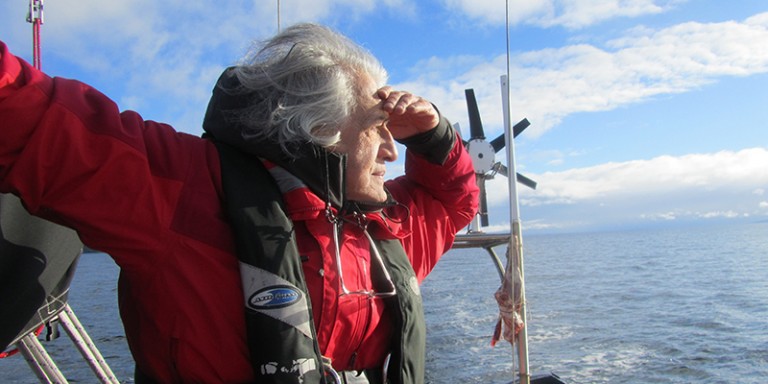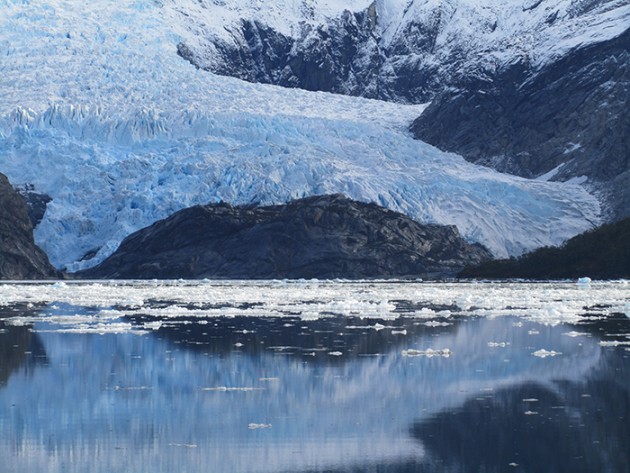
Water Is The Connection: An Interview with Patricio Guzmán
11 March, 2016Patricio Guzmán’s new documentary, The Pearl Button, is an exciting exploration of Patagonia and the connection of this land and sea with the history of the indigenous culture and the Chilean settlers. After travelling to the north to investigate the deserts of Chile in his previous film, Nostalgia for the Light (2010), this time, Patricio Guzmán goes south to discover the ocean and the history of the disappeared people. Director of the historic trilogy The Battle of Chile, Guzmán is, without a doubt, one of the most important film-makers and documentarians in Latin America. Using poetic and lyrical language, The Pearl Button takes us on a journey back in time, to the black days of Chilean history. Winner of the Silver Berlin Bear for Best Script at the Berlinale in 2015, Patricio Guzman speaks now with Sounds and Colours about his exciting new documentary.
Where were you born and where did you grow up?
I was born in Santiago of Chile in 1941 and I spent my childhood in Santiago, in a place called Viña del Mar, which is on the coast. I did my primary and secondary school in Santiago. I went to university and I studied philosophy. After that, I started making 8mm films and I decided to go into a film institute in one of the Chilean universities. Then I decided to go to Europe to study film, so I went to Madrid, which was not a good idea. It was the Spain of Franco, but it was still an extraordinary experience. There was a school in Spain that was a copy of the experimental centre of Rome. It was like a faithful copy because Franco wanted to make a cinema that would make his regime look good. But it all came upside-down. It’s the cinema institute where Carlos Saura studied and Berlanga came out of there. Also, Bardem, Víctor Erice and all the left-wing film-makers of Spain came out of that school. That was my studies.
Did the social and political situation of Chile influence you and drive you into film-making?
Yes, it was exactly this and even more. I began to understand Chilean politics in Spain. When I got to Spain, I didn’t have a political conscience at all. And that’s where I began to find it. So, when I went back to Chile, the first thing I did was to make a film about what was going on.
Throughout your career, you have chosen the documentary form over the fiction. Why is that?
Because at that time, I saw some extraordinary documentaries – To Die in Madrid, Reichenbach’s America As Seen by a Frenchman, Europa Di Notte by Alessandro Blasetti, The Mystery of Picasso, The Clouseau and The Living Desert from Walt Disney. A selection of amazing documentaries got me interested. I realised that these were the films that most interested me, and they were at that time at the cinemas of Santiago. At that time, there was little difference between auteur films and commercial cinema. Everything was considered the same. So, these films were a huge success. I decided that I was passionate about the style of documentary.
The Battle of Chile can be called ‘socially engaged art’ with direct messages to the audience. But in your last two films, there is a more lyrical and poetic language. How did you change to something like that?
It’s impossible to know. But I can give you more information. After making The Battle of Chile, I made a film on religion in Latin America, which is called The Southern Cross and is a panorama of the religion in Guatemala, Ecuador, Peru, Brazil and Mexico. It’s a magical film, which is closer in spirit to the last ones. It was produced by Spanish television and it was very badly distributed. But I have copies and I distribute it myself. That’s where that started, between social subjects and this magical thing of society, which is religion.
Has your ideology changed since then?
No. There is a sequence in one of my early films where there is a small car and the way is filmed and observed, is very similar to the kind of work I’m doing now, so you can see a correlation there.
What was the catalyst for making The Pearl Button? What drove you to Patagonia?
After making Nostalgia for the Light in the north, I thought that the other extremity of the country could be an interesting story. So, I decided to go to Patagonia [see image below] to see if it’s true. I had never been there before. I hired a boat 15 meters long, we went through the channels and fjords and I learnt about the Indians that had lived there before. And that set if all off.

It is very interesting how you combine the two stories, the extermination of the indigenous and the extermination of the Allende’s supporters, in The Pearl Button.
I found that the connection was the water. Because the Indians lived on the water and off the water, they ate what the water produced and they moved with canoes. The victims of Pinochet were thrown into the sea. So, the water is the connection.
In The Battle of Chile, you are preoccupied with the USA’s intervention in Chile and the struggle for national liberation and independence. What do you think about the level of Chile’s independence nowadays?
Chile has gone backwards. Now there are even more American companies, especially with the copper mines and other areas of the economy. Chile has become just another Latin American country and it wasn’t like that before. It was far more independent. It was poorer but more independent.
What are your plans for the future?
I want to make a film about the Andes mountain range.
Will it be the third part of the trilogy?
Exactly. It will be a film that will show the people who live in the mountains, inside the mountains, usually solitary people, but very interesting. I want to interview the people who live in the foothills of the Andes. The mountain range is like a wall that doesn’t let some ideas go by and people take refuge there, by that wall. I want to know why they take refuge there and if that’s a good thing or not. I don’t know what I will find, but I want to use that as a starting point. It’s an amazing mountain range, it’s like the Himalayas, it’s enormous. And it’s quite extraordinary to go within it.
The Pearl Button is in UK cinemas from March 18th, with some special previews featuring Q&A’s with Patricio Guzmán between March 10th and March 13th. For more details on where The Pearl Button is screening visit newwavefilms.co.uk/view-film-detail.html?viewListing=MTMy&cat=1 (click ‘Where It’s On’ on the left for screening dates)
Follow Sounds and Colours: Facebook / Twitter / Instagram / Mixcloud / Soundcloud / Bandcamp
Subscribe to the Sounds and Colours Newsletter for regular updates, news and competitions bringing the best of Latin American culture direct to your Inbox.

